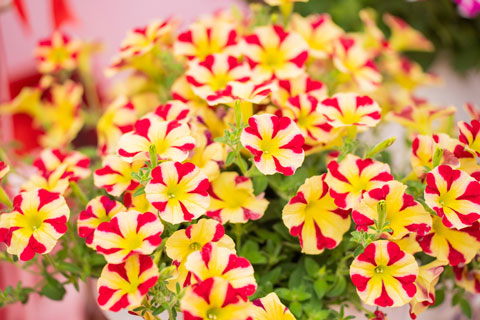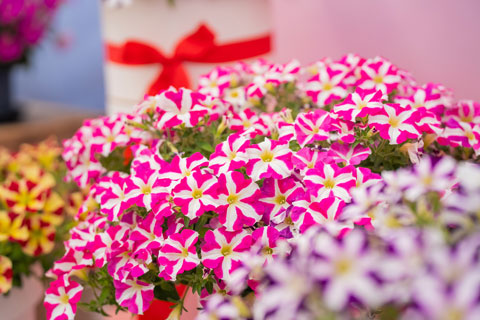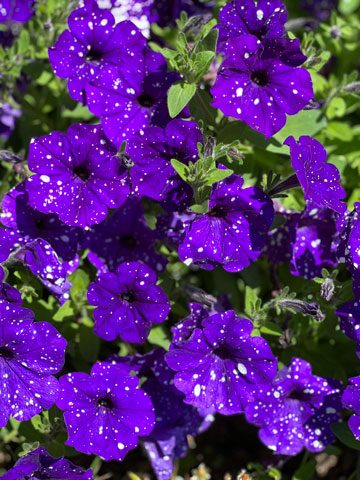1/1/2024
Perfecting Patterned Petunias
Mike Fernandez


Home gardeners are seeing stars, hearts and speckles as they flock toward patterned petunias. These unique patterned blooms are a draw at retail. As a result, breeders are working diligently to develop varieties that hold their patterns, shapes and speckles throughout the growing season.
Pictured: Amore Queen of Hearts, and Amore Pink Hearts petunias.
Recent breakthroughs in breeding are making those patterns more consistent, but there are a few things growers can do to produce a high-quality crop that will create a good experience for both retailers and home gardeners. These tips and tricks for growers help keep the patterns looking good at retail, ensuring these novelties fly off the shelf. With a good first start, these petunias can look great all season long for home gardeners, too, making them feel successful in their gardening tasks.
Making a splash with speckles, sharing the love with hearts
When it comes to novelty varieties, choosing the right genetics is key. Many novelty varieties struggle to perform well as temperatures rise. Developing our varieties in Israel gives us an advantage when it comes to heat tolerance. Danziger varieties are naturally able to handle the high temperatures. The goal with our Amore and Splash Dance Petunia series was to create a lineup that holds its pattern even in the heat of summer. With the proper growing techniques, the heart shapes of Amore and speckled patterns of Splash Dance hold exceptionally well.
Propagation tips for patterned and speckled petunias
Patterned petunias can be affected by heat. They can also be affected by PGRs. Paying special attention to temperature and application amounts is important.
It’s recommended to stick both Amore and Splash Dance Petunias on priority. Average growth time is four weeks. We recommend reducing temperatures at Week 3 and reducing irrigation mist as soon as possible.
Both series are well-branched, so there’s no need to pinch for a quality finish. Growth regulator applications are minimal. Paying attention to the amounts and number of applications can help the patterns hold.
Soil pH is crucial for success. We recommend keeping the pH level from 5.6 to 6.0 throughout propagation.
Week 1
Keep temperatures between 72 and 74F (22 and 23C). For fertilization, feed with 50 ppm N in mist. Supplement with additional lighting if needed in your region. Applying B-Nine the day after sticking at 2,500 ppm can prevent stretching in propagation. Fungicide is also recommended the day after sticking.
Week 2
Similar to Week 1, be sure to keep temperatures between 72 and 74F. Feed with 50 ppm N in mist. This can also be supplemented by hand watering with a hose. Be sure to complete a second fungicide application.
Week 3
Cool temperatures to 68F (20C) and increase fertilization to 100 to 150 ppm N.
Week 4
Keep temperatures between 65 to 68F (18 and 20C) and feed 100 to 150 ppm N. Regulate growth with Damionzide at 2,500 ppm to 5,000 ppm as needed as spray application.
 Pictured: Splash Dance Bolero Blue petunias.
Pictured: Splash Dance Bolero Blue petunias.
Finishing tips
Average finishing time from liners is eight to 10 weeks. Cool temperatures, between 68 to 70F (18 to 21C), provide the best range for high-quality finishing. Pay special attention to your temperatures. You want to make sure you don’t dip too low to keep finishing times on track. Lower temperatures can be used, but you’ll need to add time to finish.
Soil & water
Be sure to maintain lower soil pH levels for optimal Iron and Manganese availability to plants. 5.6 to 6.0 is your optimal target range. Additional Iron or Manganese may be required depending on water quality and alkalinity.
Monitoring your water is key for just about any crop. Knowing the pH of your water can help you make the right decisions about additives.
We recommend sub-irrigation or watering early in the day to control humidity. Using this process can also eliminate the possibility of moisture sitting on the leaves for an extended period of time throughout the day. Be sure you’re not over-saturating the soil.
Light
Both Splash Dance and Amore will flower in a 10-hour day, but supplemental lighting in low light areas is beneficial. There’s no need to light these petunias for more than 12 hours.
Growth regulators
PGRs can affect your patterns. PGR spray or drench is best done before flower buds are forming. Also, lower rates are better.
If you’re using B-Nine and typically apply at 2,500 ppm, it’s better to do two applications at 1,250 ppm each time.
If you’re using a Paclobutrazol drench, instead of applying at 2 ppm, apply twice at 1 ppm each time for finishing.
Pest & disease control
If you’re experiencing aphid or thrips concerns, pests can be controlled by common insecticides. For aphids, we recommend applying acetamiprid, flonicamid, imidacloprid or dichlorvos. For thrips, methiocarb, acrinathrin, abamectin, dichlorvos or spinosad can be used.
For Botrytis, cyprodinil+fludioxonil, iprodione or polyoxin can be used. Pythium and Phytophthora can be controlled with propamocarb.
As with any crop, paying attention to the small details with patterned petunias can make a big difference. More details can be found on DanzigerOnline.com. GT
Mike Fernandez is the market manager for Danziger North America and can be reached via email at mike@danziger.co.il.